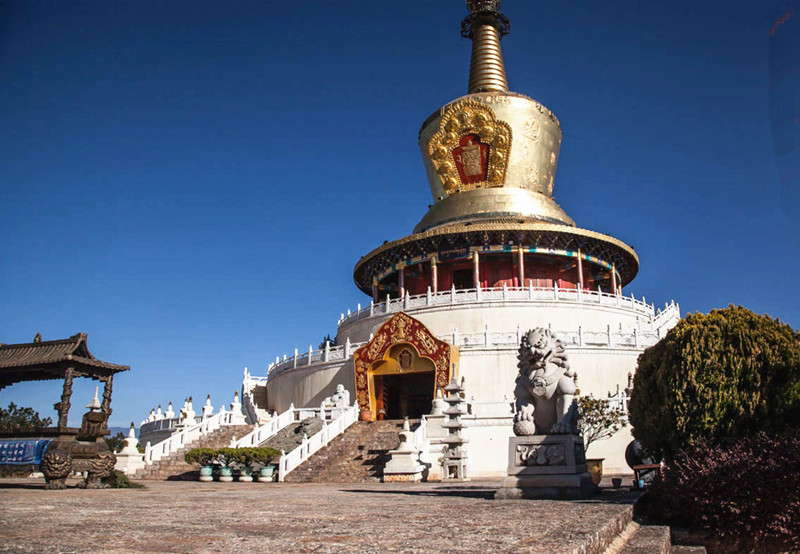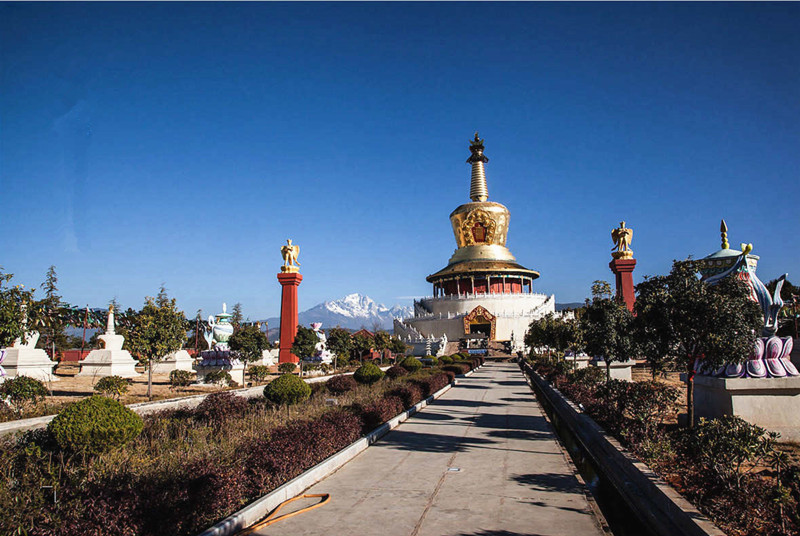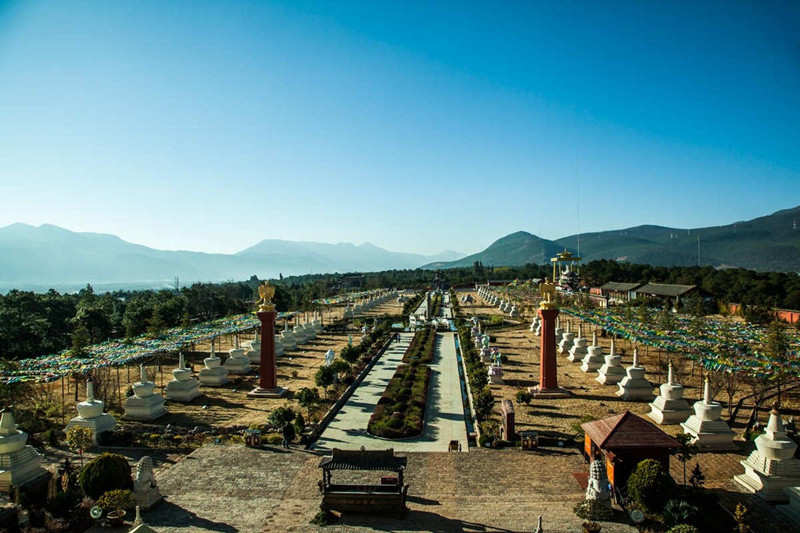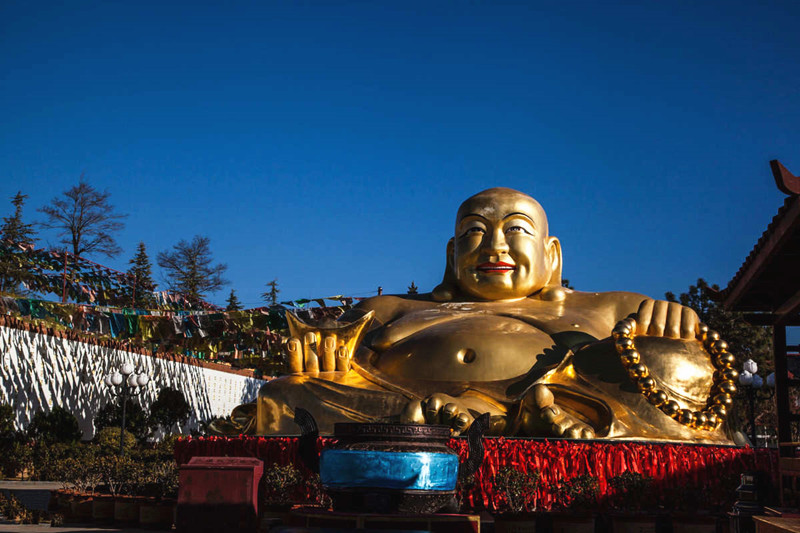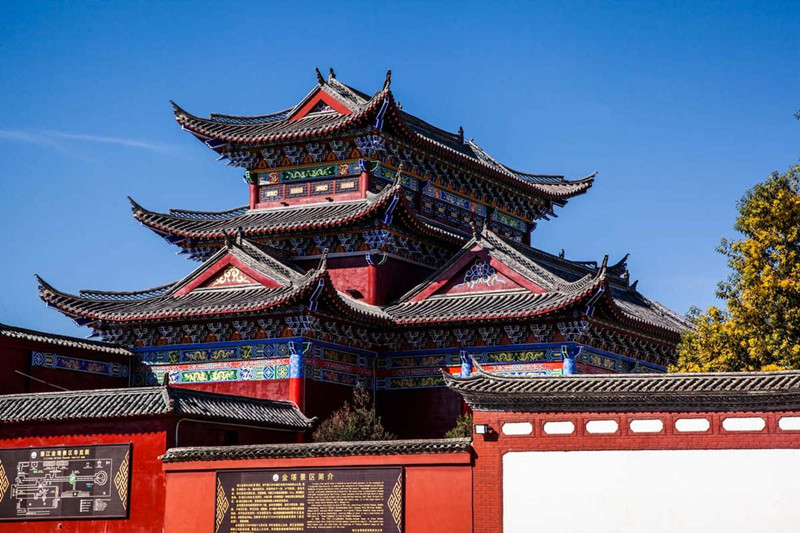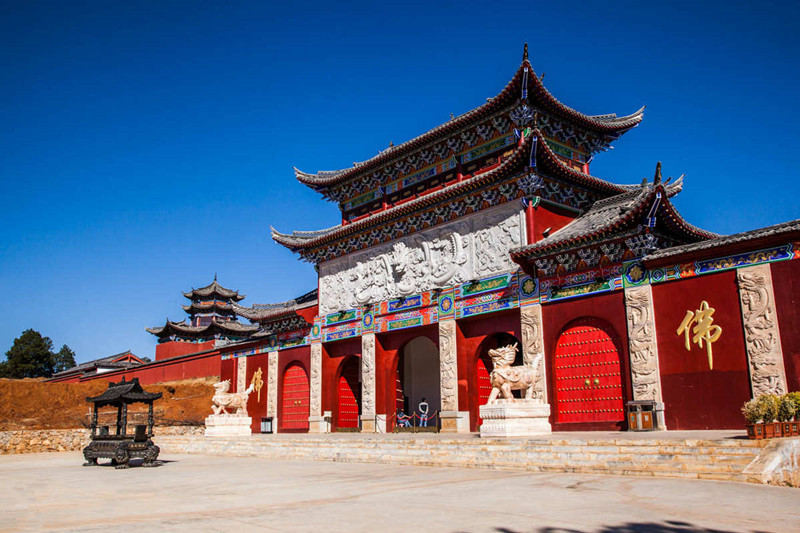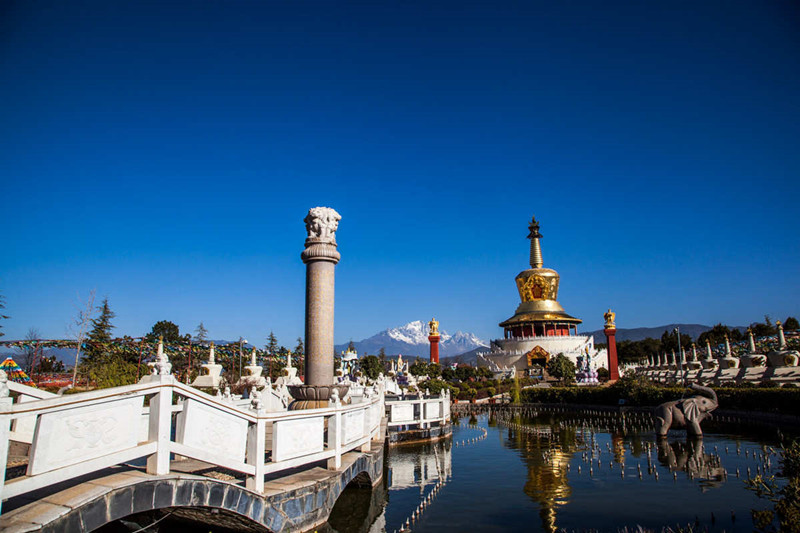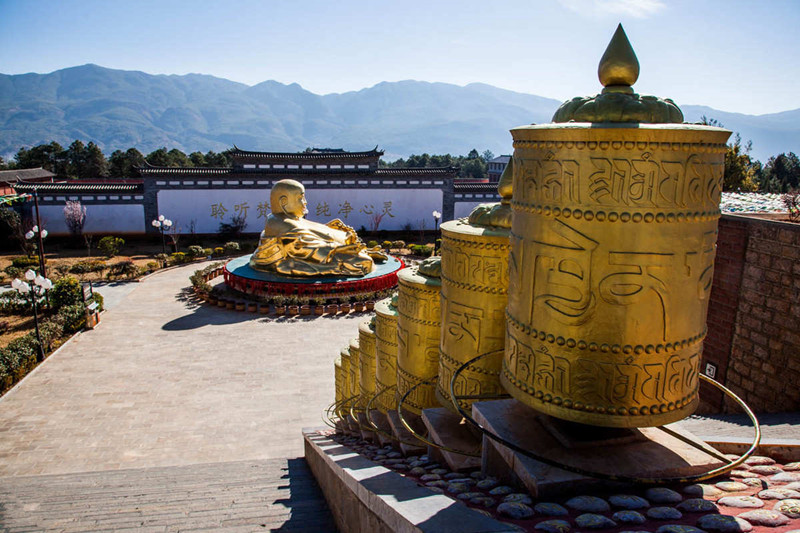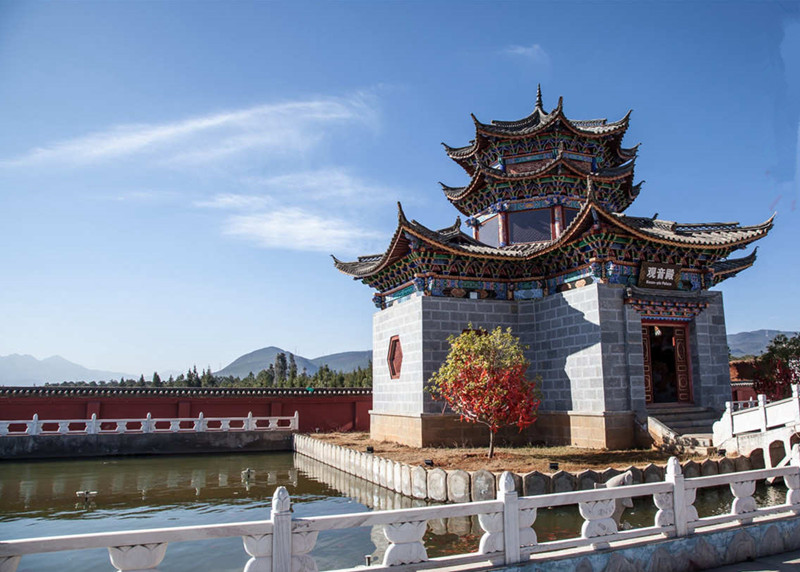
Golden Pagoda Temple Scenic Area in Lijiang
Overview
The Golden Pagoda Temple (金塔寺) is a folk temple that was originally built during the Tang Dynasty. It has undergone numerous reconstructions during the Ming and Qing Dynasties. The scenic area covers an area of 109.2 acres, with more than 40% of it designated as green space. It features several key attractions, including the statue of Master Lotus (莲花大师法像), the Guanyin Hall (观音殿), the Hall of Thousand Buddhas and Ten Thousand Lamps (千佛万灯殿), the Ashoka Pillar (阿育王柱), the Maitreya Buddha (弥勒佛), and the Great Hall of 81 Wealth Gods (合18路81尊财神坛城大殿).
Landmark: East Treasure Victorious Tower (东宝尊胜塔)
The iconic East Treasure Victorious Tower is a stupa personally authorized by the Buddha and is the only golden stupa in Chinese Tibetan Buddhism. The tranquil and beautiful tower can only be witnessed by the Bodhisattva on Earth; ordinary people cannot see it. It is said that during the years the tower was destroyed, natural disasters were frequent, and human calamities were incessant. Villagers near the old site of the tower are aware that those who destroyed it met with terrible fates, suffering from sickness and disasters in subsequent generations. Those who took the tower’s bricks home also faced misfortune. After the tower was rebuilt, rain fell all around it, yet the tower itself remained illuminated by sunshine.
The Victorious Tower stands proudly atop Snake Mountain (蛇山), bringing favorable weather, prosperous livestock, abundant harvests, cultural flourishing, and the emergence of distinguished individuals, all contributing to the well-being of the people.
Geographic Location
The Golden Pagoda Temple is strategically located about 4.5 kilometers from the ancient city of Lijiang, near Lijiang Airport, Lijiang Railway Station, the Dali Highway (Airport Expressway), and the southern bypass of Lijiang, providing convenient transportation. It is a landmark site on the tourism route connecting Lijiang, Dali, and Shangri-La.
Scenic Attractions
1. Heavenly Kings Hall (天王殿)
The Heavenly Kings Hall is dedicated to the Four Heavenly Kings: the Eastern Guardian King (东方持国天王) holding a pipa, the Southern Growth King (南方增长天王) wielding a sword, the Western Wide-Eyed King (西方广目天王) entwined in a red dragon, and the Northern Many-Listen King (北方多闻天王) holding a precious umbrella. Each represents various virtues: responsibility, wisdom, impermanence, and protection against worldly pollutants.
2. Prayer Wheel (转经筒)
The prayer wheel, also known as the “Mani Prayer Wheel” (嘛呢转经筒), is inscribed with the six-syllable mantra “Om Mani Padme Hum” (嗡嘛呢呗咪吽). Inside the wheel is a scroll containing the mantra, and spinning the wheel symbolizes reciting it a thousand times. Tibetan Buddhism teaches that the more one recites this mantra, the greater the merits and benefits gained, potentially leading to liberation from the cycle of rebirth.
3. Maitreya Buddha (弥勒佛)
Maitreya Buddha is known as the Future Buddha. His golden body symbolizes wealth and joy. A verse describes him as follows: “开口便笑,笑古笑今,凡事付之一笑; 大肚能容,容天容地,于人何所不容。”
4. Guanyin Hall (观音殿)
Guanyin Hall, representing Han Chinese Buddhism, is dedicated to the Great Compassionate Guanyin Bodhisattva. Statues of Master Xu Yun (虚云大师) and Elder Ben Huan (本焕长老) flank the hall. The interior walls are painted with various forms of Guanyin, signifying her responsiveness to the needs of sentient beings. Master Xu Yun and Elder Ben Huan significantly contributed to the deep exchange between Han and Tibetan Buddhism.
5. Hall of Thousand Buddhas and Ten Thousand Lamps (千佛万灯殿)
The Hall of Thousand Buddhas and Ten Thousand Lamps is the most characteristic structure in the scenic area, housing a thousand Buddha statues and ten thousand lamps. Buddha once said, “如染香人,身有香气.” Offering three lamps to the Buddha symbolizes dedication to the Three Jewels (Buddha, Dharma, Sangha), enhancing moral discipline, meditation, and wisdom, while eliminating greed, anger, and ignorance.
6. Master Padmasambhava (莲花生)
Master Padmasambhava is a principal figure in esoteric Buddhism. His statue, imported from Myanmar, is carved from a single block of white jade, weighing 200,000 kg and valued at over 11 million yuan. He is known for his mastery of both “spiritual techniques” and “mantras,” symbolizing great wisdom and the ability to conquer desire, anger, and ignorance.
7. White Elephant Treasure and White Stupa Forest (白象宝、白塔林)
The White Elephant Treasure, one of Tibetan Buddhism’s seven treasures, symbolizes good fortune and wealth. In ancient India, elephants were essential transport animals, representing Buddhist treasures. The White Stupa houses relics and treasures, showcasing the typical architectural structure of Tibetan Buddhism, which comprises 108 parts, symbolizing the completion of Buddhist teachings.
8. Golden Pagoda at Night (金塔夜)
Under a starry sky, the Golden Pagoda majestically stands atop Snake Mountain, illuminated by moonlight and artificial lights. From a distance, it resembles translucent glass, illuminating the entire Lijiang area and guarding the good people with blessings of peace and prosperity.
9. Ashoka Pillar (阿育王柱)
The Ashoka Pillar, made of granite and standing 13 meters tall, is valued at over 7 million yuan. It contains Buddhist scriptures inscribed on its surface, specifically the “Heart Sutra” (般若波罗密多心经), which encapsulates the essence of the Prajna teachings in just 260 words. It is said that King Ashoka, influenced by Buddhism, erected lion statues on four-sided pillars wherever Buddhism spread, known as the “Ashoka Pillars.”
10. East Treasure Victorious Tower (东宝尊胜塔)
The East Treasure Victorious Tower (Golden Pagoda) was founded based on the teachings of the Buddha Shakyamuni (释迦摩尼佛) around 2500 years ago. Initially built during the Tang Dynasty, it underwent numerous reconstructions during the Ming and Qing Dynasties. In 2004, under the blessing of the 17th Karmapa, the stupa was rebuilt atop Snake Mountain, making it the fourth documented restoration. The construction required 208 kg of gold, rendering it splendid and radiant.
The first floor of the tower houses the Lotus Master’s stupa, featuring 81 Wealth Gods, embodying the cultural essence of Confucianism, Buddhism, and Taoism. The second floor enshrines the fifth Karmapa’s golden statue and numerous precious scriptures and treasures, serving to bless all sentient beings.
How to Get There
The Golden Pagoda Temple is easily accessible by various means of transportation. If you are arriving by air, the Lijiang Airport (丽江机场) is the nearest airport, located about 30 minutes away by car. The Lijiang Railway Station (丽江火车站) is also nearby, providing convenient train services. You can take the Dali Highway (大丽公路) or the southern bypass road to reach the scenic area. Local taxis and ride-sharing services are available for a hassle-free journey.
Travel Tips
- Best Time to Visit: The ideal time to visit the Golden Pagoda Temple is during spring and autumn when the weather is pleasant, and the scenery is most beautiful.
- Dress Code: While visiting the temple, dress modestly and respectfully, as it is a sacred site.
- Photography: Photography is allowed in most areas, but be mindful of not disturbing others during prayers or ceremonies.
- Cultural Etiquette: Show respect when observing rituals, and remember to remove your shoes before entering sacred spaces.
- Local Cuisine: Don’t miss the opportunity to try local delicacies in the nearby areas of Lijiang, including Yunnan rice noodles and various ethnic dishes.
